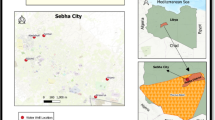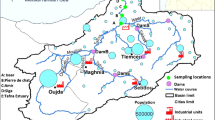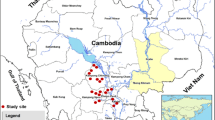Abstract
An ensemble of thirty physico-chemical characteristics was used to assess the quality of well waters in four urban centers in southern Nigeria: Lagos, Benin City, Warri, and Ekpoma. The characteristics investigated include pH; color; turbidity; salinity; electrical conductivity, EC; total dissolved solids, TDS; total suspended solids, TSS; dissolved oxygen, DO; total hydrocarbon, THC; biochemical oxygen demand, BOD; chemical oxygen demand, COD; and nitrate, nitrite, ammonia, sulfate, and phosphate concentrations. Also monitored were the concentrations of sodium, calcium, potassium, magnesium, chloride, bicarbonate, iron, lead, copper, manganese, zinc, chromium, nickel, and cadmium. The results obtained were compared with World Health Organization, WHO, and Nigerian Federal Ministry of Environment, FME, drinking water standards. The results show that with the well water obtained from Lagos, turbidity, 11.80 NTU; pH, 5.68; EC, 1065.55 μS/cm; TDS, 539.00 mg/L; concentrations of iron, 1.83 mg/L; manganese, 0.14 mg/L; and lead, 1.35 mg/L did not meet the WHO standards. In Warri, pH, 5.19; concentrations of lead, 1.35 mg/L; and chromium, 0.10 mg/L in the well water were above the WHO desirable limits. The results also indicated that the well water from Benin City contained concentrations of chromium, 0.18 mg/L; and lead, 0.20 mg/L that exceeded the recommended WHO limits. In Ekpoma, the pH, 6.00; concentrations of chromium, 0.15 mg/L; and lead, 0.44 mg/L were higher than the desirable limits of WHO. Generally, the assessments revealed that the waters were good and fit for drinking and other domestic application without serious threat to public health.

Similar content being viewed by others
References
Ademoroti CMA (1996) Environmental Chemistry and Toxicology. Foludex Press Ltd, Ibadan
Agatemor C, Okolo PO (2007) University of Benin water supply system: microbiological and physico-chemical assessments. Environmentalist 27:227–239
Akhionbare SMO (1998) Quality assessment of sources of drinking water in the Owan Area of Edo State. PhD Thesis, Department of Chemistry, University of Benin, Benin City, Nigeria
Akujieze CN, Coker SJI, Oteze GE (2003) Groundwater in Nigeria–a millennium experience: distribution, practice, problems and solutions. Hydrogeol J 11:259–274
Alan FR, John AC (1979) Groundwater. Prentice-Hall. Englewood Cliff, New Jersey
Amadi PA, Ofoegbu CO, Morrison T (1989) Hydrogeochemical assessment of groundwater quality in parts of Nigeria Delta, Nigeria. Environ Geol Water Sci 14:195–202
American Public Health Association, American Water Works Association and Water Pollution and Control Federal (APHA/AWWA/WPCF) (1998) Standard Method for the Examination of Water and Wastewater, 20th edn. Washington, DC
Asubiojo OI, Nkono NA, Ogunsua AO, Oluwole AF, Ward NI, Akanle OA, Spyron NM (1997) Trace elements in drinking and groundwater samples in southern Nigeria. Sci Tot Environ 208:1–8
Aziegbe FI (2006) Sediment sources, redistribution, and management in Ekpoma, Nigeria. J Hum Ecol 20:259–268
Black M (1998) Learning what work: a 20-years retrospective view on international water and sanitation cooperation 1978-1998. UNDP-World Bank water and sanitation programme. Available at http://www.wds.worldbank.org via the INTERNET. Accessed 2007 April 17
Davies J, MacDonald AM (1999) Final report: the groundwater potential of Oju/Obi area, Eastern Nigeria. British Geological Survey Technical Reports
Edet AE, Okereke CS (2001) A regional study of saltwater intrusion in southeastern Nigeria based on the analysis of geoelectrical and hydrochemical data. Env Geol 40:1278–1289
Edmunds WM, Gayes CB (1994) Estimating the spatial variability of groundwater recharge in the Sahel using chloride. J Hydrol 156:47–59
Edmunds WM, Fellman E, Goni IB, McNeill G, Harkness DD (1998) Groundwater, palaeoclimate and recharge in south-west Chad Basin, Borno State, Nigeria. In: Isotope Techniques in the Study of Environmental Change. Proceedings of an International Symposium, IAEA, Vienna
Edmunds WM, Fellman E, Goni IB (1999) Lakes groundwater and paleohydrology in the Sahel of NE Nigeria: evidence from hydrogeochemistry. J Geol Soc London 156:345–355
Erah PO, Akujieze CN, Eze GE (2002) The quality of groundwater in Benin City: a baseline study on the inorganic chemicals and microbial contaminants of health importance in boreholes and open wells. Trop J Pharm Res 1:75–82
Federal Republic of Nigeria Official Gazette (2007) Legal Notice on the Publication of Details of the Breakdown of National State Provisional Totals, 2006 Census. Available at http://www.nigeriastat.gov.ng/connections/pop2006.pdf via the INTERNET. Accessed on 2007 May 29
Geldreich EE, Lechevallier M (1999) Microbiological Quality Control in Distribution Systems, in American Water Works Association (ed). Water Quality and Treatment: A Handbook of Community Water Supplies, McGraw-Hill, pp 18-49
MacDonald AM (2005) Developing groundwater: a guide for rural water supply, ITDG Publishing. Available at http://www.developmentbookshop.com/ via the INTERNET. Accessed 2007 April 17
Malomo S, Okufarasin VA, Olorunnio MA, Omode AA (1990) Groundwater chemistry of weathered zone aquifers of an area underlain by basement complex rocks. J Afr Earth Sc 11:357–371
National Academy of Sciences Safe Drinking Water Committee (1977) Drinking Water and Health, vol 3. National Academy Press, Washington, DC
National Research Council (1989) Recommended Dietary Allowances, 10th edn. National Academy Press, Washington, DC
Olobaniyi SB, Efe SI (2007) Comparative assessment of rainwater and groundwater quality in an oil producing area of Nigeria: environmental and health implications. J Environ Health Res 6:111–118
Olobaniyi SB, Owoyemi FB (2004) Quality of groundwater in the Deltaic Plain Sands aquifer of Warri and environs, Delta State, Nigeria. Water Res J Niger Ass Hydrogeol 15:38–45
Schock MR (1999) Internal corrosion and deposition control. In: American Water Works Association (ed) Water Quality and Treatment: A Handbook of Community Water Supplies. McGraw-Hill. pp 2-107
Short K, Stauble AJ (1967) Outline of the geology of the Niger Delta. Am Assoc Petrol Geol Bull 51:761–779
Smith SA (1999) Source water quality management: groundwater. In: American Water Works Association (ed) Water Quality and Treatment: A Handbook of Community Water Supplies. McGraw-Hill, NY, pp 4–45
United Nations (UN) (1988) Groundwater in North and West Africa. Natural Resources/water Series, No 18, New York
Unyimadu JP, Enekwechi LO (2004) Leachate characteristics of Ojota Landfill in Lagos. J Niger Eng Soc 2:77–82
U.S. Environmental Protection Agency (1990) National Primary and Secondary Drinking Water Regulations: Synthetic Organic Chemicals and Inorganic Chemicals and Microorganisms. Fed Regist 50:46937–47022
World Health Organization (WHO) (2004) Guidelines for Drinking Water Quality, 3rd edn. Geneva
Wright JB (1985) Geology and Mineral Resources of West Africa. Allen and Unwin, London
Acknowledgments
The authors gratefully acknowledge Professor Lourdes V. Abellera and Engineer Paul A. Guilas of the Natural Sciences Research Institute, University of the Philippines, Diliman, for their help in providing Fig. 1, map of the study area. The numerous corrections and comments of Professor Abellera, which help to greatly improve the manuscript, are also appreciated.
Author information
Authors and Affiliations
Corresponding author
Rights and permissions
About this article
Cite this article
Agatemor, C., Agatemor, U.M. Physico-chemical characteristics of well waters in four urban centers in Southern Nigeria. Environmentalist 30, 333–339 (2010). https://doi.org/10.1007/s10669-010-9280-y
Published:
Issue Date:
DOI: https://doi.org/10.1007/s10669-010-9280-y




